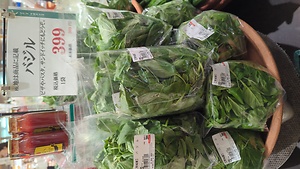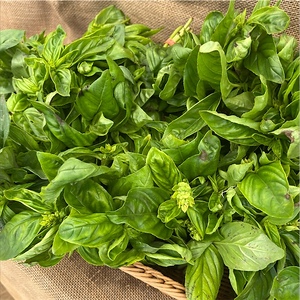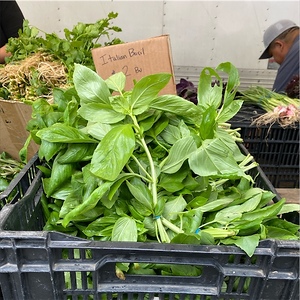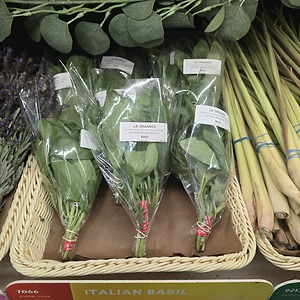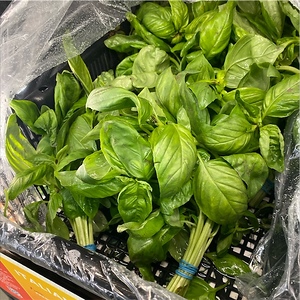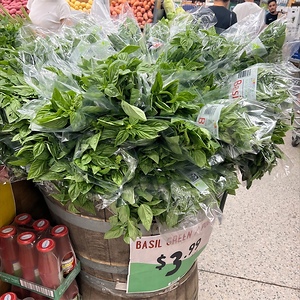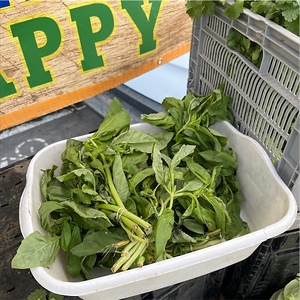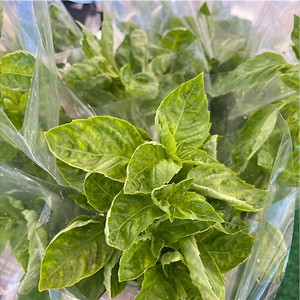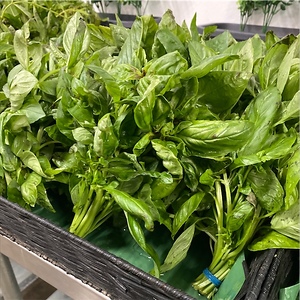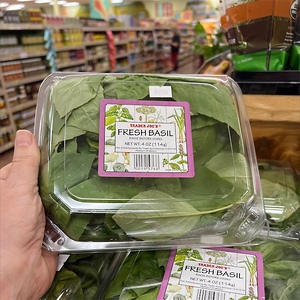


Basil
Estimated Inventory, lb : 587.79
This item was last sold on : 07/17/25
Description/Taste
Basil leaves widely range in size and appearance, depending on the specific variety, and average 3 to 11 centimeters in length with an oval to lanceolate shape. The leaf’s surface is smooth, broad, and flat with prominent veining, found in shades of bright green, dark green, and purple. The leaves also have even to serrated, jagged edges and are attached to fibrous, square stems. Basil leaves are highly fragrant and offer distinct aromas of anise, clove, citrus, cinnamon, and camphor due to a rich content of essential oils. The leaves can be harvested at multiple maturity stages, bearing different flavors with each variety, and generally have an herbal, sweet, and nutty taste with fresh licorice nuances.
Seasons/Availability
Basil is available year-round.
Current Facts
Basil, botanically a part of the Ocimum genus, is a general descriptor used to encompass many different varieties of aromatic herbs belonging to the Lamiaceae or mint family. The name Basil is derived from the Greek word basilikos, roughly translating to mean “herb worthy of a king,” and this title was given to the aromatic plant for its widespread use in medicinal and culinary applications worldwide. Ocimum basilicum, also known as Sweet Basil, is the most prevalent species commercially grown, and within the species, there are over 60 different varieties of Sweet Basil such as Dark Opal, Cinnamon, Globe, and Purple Basil. There are also well-known Basil hybrids, including Lemon and African Blue, and other Basil species such as Thai Basil grown for culinary and medicinal uses.
Nutritional Value
Basil is an excellent source of vitamin K, a nutrient that assists in faster wound healing, and is a good source of iron to build the protein hemoglobin to transport oxygen through the blood. The aromatic leaves also contain vitamin A to maintain healthy organ functioning, calcium to strengthen bones, manganese to stimulate protein digestion, and antioxidants to provide anti-inflammatory properties to protect against free radical damage. Basil contains an aromatic fragrance and flavor due to essential oils such as linalool, methyl chavicol, and eugenol. Each essential oil will be found in varying levels in different Basil varieties, giving each type a unique flavor and scent.
Applications
Basil is an aromatic herb used whole, chopped, or crushed in a wide variety of savory and sweet preparations. The leaves are most commonly used raw and are lightly torn, tossed into green salads, chopped and mixed into grain, rice, and noodle dishes, or used as a fresh topping over pizza and pasta. Basil can also be layered on toast with creamy spreads, placed inside sandwiches, infused into oils and vinegar, or blended into sauces such as pesto. Beyond fresh applications, Basil can be sauteed into eggs, stir-fried with vegetables, stirred into soups and curries, or deep-fried and served with roasted meats. The herbs can also be incorporated into sweet dishes such as sorbet or ice cream and used as a topping over shortcakes, cookies, and tarts. In addition to the leaves, Basil flower buds are edible and can be mixed into salads, soups, and bowls. Basil pairs well with nuts such as pistachios, pine nuts, and walnuts, tomatoes, zucchini, corn, artichoke hearts, radishes, bell peppers, aromatics including garlic, onion, red onion, ginger, lemongrass, and shallots, fruits such as pears, strawberries, nectarines, peaches, watermelon, and mango, and other herbs such as mint, parsley, and cilantro. Basil should be used immediately for the best quality and flavor. Fresh leaves attached to stems can be placed in a glass of water and lightly covered in the refrigerator, where they will keep up to one week. Individual leaves can also be stored in between paper towels in a plastic bag, kept in the fridge for 2 to 4 days. For extended use, Basil can be frozen in airtight plastic bags. Basil can also be dried and used as a spice, but much of the aroma and flavor will be lost in the drying process.
Ethnic/Cultural Info
In Italy, Basil has transitioned over time from a symbol of hate to a symbol of love. During the Ancient Roman Empire, many gardeners believed Basil would grow to larger sizes if the plant were yelled at and cursed while cultivating. This aggression established the herb’s hateful reputation, but later in the mid 14th century, Basil became a symbol of love and death in the story of Lisabetta and The Pot of Basil. The emotional story is contained within The Decameron, a novel written by Giovanni Boccaccio, centered around two lovers caught in a secret affair, Lisabetta and Lorenzo. One night Lorenzo was killed by Lisabetta’s brothers, and in anguish, Lisabetta cut off her lover’s head and buried it in the bottom of a potted Basil plant. Lisabetta wept over the Basil daily, and through her tears, the plant flourished and became a symbol of her lost love. The story tragically ends with the Basil plant being taken away from Lisabetta, but the tale transformed Basil's hateful reputation into a symbol of love in Italian culture. In the Middle Ages, Basil was also worn in single women's hair as a symbol of their availability for romance and was thought to help bring them love.
Geography/History
Basil is native to regions of Africa and Asia and has been growing wild for over 4,000 years. The ancient herb was introduced to the Mediterranean in the early ages through trade routes and was used for religious, medicinal, and folkloric purposes in Egyptian, Greek, and Roman civilizations. Basil was eventually spread to England during the 16th century and North America in the 17th century. Newspaper documentation mentioning the sale of Basil in New York can be found dating back to the end of the 18th century, quickly establishing the herb as a cultivated variety. Today, Basil can be found growing in warm, subtropical, and temperate regions worldwide, especially in Central Africa, Southeast Asia, the Mediterranean, New Zealand, Australia, and the United States. The herbs are cultivated for commercial use, grown in home gardens, and are also still found growing wild.
Featured Restaurants
Restaurants currently purchasing this product as an ingredient for their menu.
| Ranch Catering | San Diego CA | 858-491-9100 |
| Lumi (Bar) | San Diego CA | 619-955-5750 |
| Wine Vault & Bistro | San Diego CA | 619-295-3939 |
| Mille Fleurs | Rancho Santa Fe CA | 858-756-3085 |
| Inn at Rancho Santa Fe (Banquet) | Rancho Santa Fe CA | 858-381-8289 |
| US Grant Hotel Main | San Diego CA | 619-232-3121 |
| Pacific Cafe & Catering (Medical Cntr Dr.) | La Jolla CA | 619-808-4087 |
| The Cordova Bar | San Diego CA | 619-230-5950 |
| Higher Grounds Coffee + Cafe | San Diego CA | 831-247-5395 |
| Bernardo Heights Country Club | San Diego CA | 858-487-4022 |
| Moxy San Diego Gaslamp | San Diego CA | 619-376-1850 |
| Nomad Donuts | San Diego CA | 619-431-5000 |
| Common Theory | San Diego CA | 858-384-7974 |
| Chef Sebastian LLC | La Jolla CA | 858-740-0878 |
| The Wild Thyme Company | San Diego CA | 858-527-0226 |
| Madison | San Diego CA | 619-822-3465 |
| Darshan Bakery (Del Mar) | Del Mar CA | 858-925-7223 |
| Sbicca Del Mar | Del Mar CA | 619-417-2587 |
| Alila Marea Beach Resort | Encinitas CA | 805-539-9719 |
| Born & Raised | San Diego CA | 619-944-1631 |
| Piatti | San Diego CA | 858-454-1589 |
| Donna Jean | San Diego CA | 619-392-0052 |
| The Crack Shack Costa Mesa | Costa Mesa CA | 951-808-7790 |
| Fernside | San Diego CA | 619-398-5156 |
| Uptown Tavern | San Diego CA | 619-683-9322 |
| Harry's Coffee Shop - Del Mar | Del Mar CA | 858-794-6838 |
| LG Personal Chef | San Diego CA | 858-204-3464 |
| Village Vino | San Diego CA | 619-546-8466 |
| Cucina Urbana (Bar) | San Diego CA | 858-232-7808 |
| Harvest Kitchen | Vista CA | 619-709-0938 |
| Haven | San Diego CA | 619-928-2086 |
| Happy Medium SD | San Diego CA | 509-869-2279 |
| Miho | San Diego CA | 619-365-5655 |
| Zanzibar at the Loft | La Jolla CA | 858-210-5476 |
| Cape Rey Carlsbad, a Hilton Resort | Carlsbad CA | 760-602-0800 |
| Bleu Boheme | San Diego CA | 619-255-4167 |
| Lucky Bolt | San Diego CA | 662-832-3638 |
| Bernini's Bistro | La Jolla CA | 858-454-5013 |
| The Local-Pacific Beach | San Diego CA | 858-263-7475 |
| The Whaling Bar (Bar) | La Jolla CA | 858-355-9218 |
| WaterBar | San Diego CA | 619-308-6500 |
| Golden Door | San Marcos CA | 760-761-4142 |
| Kona Kai Resort and Marina | San Diego CA | 619-221-8000 |
| Sugar Bear Enterprises | San Diego CA | 925-383-3623 |
| Prager Brothers (Hillcrest) | San Diego CA | 760-445-0831 |
| Neighborhood Burger | San Diego CA | 619-446-0002 |
| LPM Master Tenant, LLC- Bottlecraft | San Diego CA | 619-522-6890 |
| Secret Sister | San Diego CA | 619-281-0718 |
| Viewpoint Brewing Co. | Del Mar CA | 858-205-9835 |
| Green Dragon Tavern & Museum | Carlsbad CA | 760-797-5579 |
| Ketch Grill and Taps | San Diego CA | 858-268-1030 |
| Bekker's Catering | San Diego CA | 619-287-9027 |
| Extraordinary Desserts | San Diego CA | 619-294-2132 |
| Barleymash | San Diego CA | 619-255-7373 |
| Manna | Encinitas CA | 510-366-3057 |
| Carte Hotel | San Diego CA | 619-365-1858 |
| Glenbrook Health Center | Carlsbad CA | 760-704-1000 |
| insideOUT (Bar) | San Diego CA | 619-793-9221 |
| Brockton Villa Restaurant | San Diego CA | 858-454-7393 |
| The Roxy Encinitas | Encinitas CA | 760-230-2899 |
| Cody's La Jolla | La Jolla CA | 858-459-0040 |
| The Beau Hotel | San Diego CA | 619-310-5160 |
| Deeply Nourished | La Jolla CA | 808-489-7366 |
| Crest Cafe | San Diego CA | 619-295-2510 |
| Hilton Garden Inn - Homewood Suites San Diego | San Diego CA | 619-696-6300 |
| insideOUT | San Diego CA | 619-888-8623 |
| GelatoLove | Carlsbad CA | 760-297-0554 |
| Primal Balance Nutrition LLC | Vista CA | 818-259-0995 |
| Huntress (Banquet) | San Diego CA | 619-955-5750 |
| Rancho Bernardo Inn | San Diego CA | 877-517-9340 |
| Pendry SD (Provisional) | San Diego CA | 619-738-7000 |
| South O Brewing Catering | Oceanside CA | 925-381-5392 |
| Dave Martin | San Diego CA | 949-378-2006 |
| Beaumont's | San Diego CA | 858-459-0474 |
| Something Homemade (Glutenus Maximus) | Vista CA | 858-245-1004 |
| Bridges at Rancho Santa Fe | Rancho Santa Fe CA | 858-759-6063 |
| UCSD Food & Nutrition Department La Jolla | San Diego CA | 858-761-1269 |
| Bread & Cie Café | San Diego CA | 619-683-9322 |
| Coin-Op Game Room (Downtown) | San Diego CA | 619-255-8864 |
| Ulivo | San Diego CA | 619-962-7345 |
| Cal A Vie | Vista CA | 760-945-2055 |
| The Morning Grove | Carlsbad CA | 7605000465 |
| Vertex - Merryfield Row | San Diego CA | 619-405-8950 |
| Catamaran | San Diego CA | 858-488-1081 |
| Third Corner Encinitas | Encinitas CA | 760-942-2104 |
| Grossmont-Cuyamaca Community College District | El Cajon CA | 619-644-7585 |
| Artifact at Mingei | San Diego CA | 619-846-2164 |
| The Farm Golf Club | Rancho Santa Fe CA | 858-756-5585 |
| Toast Cafe | San Diego CA | 858-208-9422 |
| Vista Valley | Vista CA | 760-758-2800 |
| Saint Mark Golf and Resort, LLC | San Marcos CA | 508-320-6644 |
| The Santaluz Club Inc - Bistro Kitchen | San Diego CA | 858-759-3150 |
| Syrah Spirit & Wine Parlor | San Diego CA | 619-234-4166 |
| All Aspects Catering and Events | San Diego CA | 855-287-7658 |
| Inn at Rancho Santa Fe | Rancho Santa Fe CA | 858-381-8289 |
| Kettner Exchange Bar | San Diego CA | 909-915-9877 |
| Marriott Gaslamp | San Diego CA | 619-696-0234 x6051 |
| Bayhill Tavern | San Diego CA | 858-288-6923 |
| Rancho Valencia | Del Mar CA | 858-756-1123 |
| Village Pizzeria Bay Side | Coronado CA | 619-522-6890 |
| Pizza Kaiju | San Diego CA | 619-240-2716 |
| The Mission EV | San Diego CA | 619-232-7662 |
| Morning Glory | San Diego CA | 619-629-0302 |
| Peace Pies | San Diego CA | 619-618-6960 |
| The Victorian at Hill Street | Oceanside CA | 442-266-8285 |
| Tavola Nostra Pizzeria E Cucina | San Diego CA | 619-921-4206 |
| Pacific Yacht Agents | Los Angeles CA | 808-214-0970 |
| The Crack Shack PB | San Diego CA | 619-450-7978 |
| Sheraton Carlsbad (20/20) | Carlsbad CA | 760-827-2400 |
| AC Hotel by Marriott SD | San Diego CA | 248-703-3310 |
| Bistro du Marche by Tapenade | La Jolla CA | 858-551-7500 |
| Tipsy Crow | San Diego CA | 619-338-9300 |
| Dolce Pane & Vino | Del Mar CA | 858-832-1518 |
| US Grant Hotel Grill | San Diego CA | 619-232-3121 |
| Red Tail Catering | San Marcos CA | 858-605-8219 |
| Crown Point Catering | San Diego CA | 619-223-1211 |
| Marriott Courtyard Old Town | San Diego CA | 619-260-8500 |
| The Lion Share Bar 2025 | San Diego CA | 619-564-6924 |
| Rubicon Deli-UTC | San Diego CA | 858-877-9911 |
| Isola Pizza Bar | San Diego CA | 619-564-2938 |
| Brigantine Pt Loma | San Diego CA | 619-224-2871 |
| Vagabond Sportfishing Inc. | San Diego CA | 619-993-9575 |
| Vulture / Dreamboat | San Diego CA | 858-342-3609 |
| Hilton La Jolla Torrey Pines | La Jolla CA | 858-450-4581 |
| Venissimo Cheese Del Mar | Del Mar CA | 858-847-9616 |
| Addison Del Mar | Del Mar CA | 858-350-7600 |
| Oliver & Rose | San Diego CA | 619-300-3395 |
| Home & Away - Old Town | San Diego CA | 619-886-1358 |
| Bishop School | San Diego CA | 858-459-4021 |
| SIE Culinary Management | San Diego CA | 858-964-8677 |
| The Tavern Bar | Coronado CA | 602-628-5890 |
| Paradisaea Bar | La Jolla CA | 732-915-6669 |
| The Joint | San Diego CA | 619-222-8272 |
| Crudo Cevicheria & Oyster Bar | San Diego CA | 619-313-9127 |
| Juniper & Ivy | San Diego CA | 858-481-3666 |
| Village Pizzaria | Coronado CA | 619-522-6890 |
| Kensington Cafe | San Diego CA | 619-684-0044 Fausto |
| Rabbit Hole | San Diego CA | 619-255-4653 |
| Continental Catering Inc | La Mesa CA | 907-738-9264 |
| The Mission MB | San Diego CA | 858-488-9060 |
| Stone Brewing-Liberty Station | San Diego CA | 619-269-2100 |
| Golden Door Bakery | San Marcos CA | 760-761-4142 |
| Hyatt Islandia | San Diego CA | 619-224-1234 |
| Animae | San Diego CA | 619-925-7908 |
| Mister A's | San Diego CA | 619-239-1377 |
| Solare Ristorante Lounge | San Diego CA | 619-270-9670 |
| Prager Brothers (Encinitas) | Encinitas CA | 760-704-8441 |
| Brigantine La Mesa | La Mesa CA | 619-465-1935 |
| Yoann Taboyan, Personal Chef | San Diego CA | 347-277-1958 |
| Convention Center Shell | San Diego CA | 619-954-3063 |
| Nadolife Production | San Diego CA | 619-239-1224 |
| Shogun Sportfishing | San Diego CA | 619-226-8030 |
| Paradisaea Restaurant | La Jolla CA | 732-915-6669 |
| Park & Rec | San Diego CA | 619-717-3925 |
| Ciccia Osteria | San Diego CA | 619-674-4069 |
| Mabel's Gone Fishing | San Diego CA | 619-228-9851 |
| Marriott Courtyard - Broadway | San Diego CA | 619-446-3008 |
| Park Hyatt Aviara (Ember & Rye) | Carlsbad CA | 760-448-1234 |
| La Jolla Country Club | San Diego CA | 858-454-9601 |
| Solterra Winery + Kitchen | Encinitas CA | 858-245-6146 |
| Tahona (Kitchen) | San Diego CA | 619-573-0289 |
| Oscars Brewing Company | Temecula CA | 619-695-2422 |
| Side Bar | San Diego CA | 619-348-6138 |
| Miguel's Old Town | San Diego CA | 619-298-9840 |
| Maderas Golf Club | Poway CA | 858-451-8100 |
| Hilton Mission Valley | San Diego CA | 619-543-9000 |
| Campfire | Carlsbad CA | 760-637-5121 |
| Town & Country Arlo | San Diego CA | 619-291-7131 |
| Panama 66 | San Diego CA | 619-206-6352 |
| Grass Skirt (Bar) | San Diego CA | 858-412-5237 |
| We Olive La Jolla | San Diego CA | 858-551-8250 |
| Casa | San Diego CA | 619-581-3003 |
| Park Hyatt Aviara | Carlsbad CA | 760-448-1234 |
| Mission Bay Beach Club | San Diego CA | 858-201-7551 |
| Callie | San Diego CA | 619-947-9036 |
| Chocolate Bar | Carlsbad CA | 442-500-2007 |
| Firefly Beach | San Diego CA | 619-222-6440 |
| San Diego Yacht Club | San Diego CA | 619-758-6334 |
| Fishery | San Diego CA | 858-272-9985 |
| 31ThirtyOne by Deckman | San Diego CA | 619-495-9814 |
| Il Giardino di Lilli | La Jolla CA | 619-467-9897 |
| The Seabird Resort | Oceanside CA | 442-222-9505 |
| Fresco Cocina (Bar) | Carlsbad CA | 760-720-3737 |
| Stake Chophouse & Bar | Coronado CA | 619-522-0077 |
| Top of the Market | San Diego CA | 619-234-4867 |
| KI's | Encinitas CA | 760-586-8289 |
| Royal Polaris Sportfishing | San Diego CA | 619-226-8030 |
| Shore Rider | La Jolla CA | 858-412-5308 |
| Sets Kitchen and Bar | San Marcos CA | 970-390-2148 |
| OB Noodle House Bar 1502 | San Diego CA | 619-255-9858 |
| Caffe Calabria Coffee Roasting Company | San Diego CA | 619-683-7787 |
| Rubicon Deli India Street | San Diego CA | 619-200-4201 |
| Coco Maya by Miss Bs | San Diego CA | 858-245-3780 |
| The Smoking Goat | San Diego CA | 858-232-4220 |
| Leucadia Pizza Point Loma | San Diego CA | 619-295-2222 |
| Fox Point Farms | Encinitas CA | 619-892-0553 |
| The Pearl Hotel | San Diego CA | 877-732-7573 |
| Urbn Pizza Kitchen | San Diego CA | 619-255-7300 |
| Desserts by Clement | San Diego CA | 619-919-4523 |
| Cellar Hand | San Diego CA | 334-689-2388 |
| Crust & Brew | San Diego CA | 858-212-8751 |
| Pacifica Del Mar | Del Mar CA | 858-792-0505 |
| Bica | San Diego CA | 619-669-5725 |
| Olive Tree Marketplace | San Diego CA | 619-224-0443 |
| Craft House Fashion Valley | San Diego CA | 619-948-4458 |
| Joya Kitchen | San Diego CA | 619-255-5979 |
| Saiko Sushi-Coronado | Coronado CA | 619-435-0868 |
| The Kitchen at MCASD | La Jolla CA | 619-880-8719 |
| De La Vina | San Diego CA | 619-990-6124 |
| Aztec Shop Catering | San Diego CA | 619 594-3576 |
| Sonny's Pizza | San Diego CA | 619-432-1838 |
| Something Homemade | Vista CA | 858-245-1004 |
| Far Corner | San Diego CA | 619-549-0838 |
| Crafted @ Minerva's Cafe | La Jolla CA | 858-699-4129 |
| La Jolla Beach & Tennis Club | San Diego CA | 619-816-8319 |
| Relic Bageri LLC | San Diego CA | 619-335-6328 |
| Jack & Giulio's | San Diego CA | 619-294-2074 |
| Sandpiper Wood Fired Grill & Oysters | La Jolla CA | 858-228-5655 |
| University Club | San Diego CA | 619-234-5200 |
| Wormwood (Bar) | San Diego CA | 619-573-0289 |
| 619 Spirits | San Diego CA | 509-701-9534 |
| Marys Gourmet Salads | La Jolla CA | 858-925-4690 |
| The Original 40 Brewing | San Diego CA | 619-206-4725 |
| Communion (Paradis) | San Diego CA | 619-606-5568 |
| The Flavor Chef (Catering) | Vista CA | 619-295-3172 |
| Wayfarer Bread | La Jolla CA | 805-709-0964 |
| The Lion Share Bar | San Diego CA | 619-564-6924 |
| Finca North Park | San Diego CA | 619-581-3003 |
| Nutmeg Bakery & Cafe 1 | San Diego CA | 858-405-2401 |
| Luce | San Diego CA | 619-275-2094 |
| Pacific Regent La Jolla | San Diego CA | 858-597-8008 |
| Common Theory Chula Vista (Bar) | Chula Vista CA | 619-495-3689 |
| Chateau La Jolla | San Diego CA | 858-459-4451 |
| Corbeaux Wine & Tea House | Temecula CA | 909-567-6109 |
| Dough Momma | La Jolla CA | 858-346-6692 |
| Cucina Enoteca (Bar) | Del Mar CA | 619-239-2222 |
| Barbarella La Jolla | La Jolla CA | 858-454-7373 |
| Communal Coffee | San Diego CA | 619-305-9525 |
| Lucien | La Jolla CA | 707-387-7163 |
| The Flower Pot Cafe and Bakery | La Jolla CA | 858-454-5453 |
| Communal Coffee - Oceanside | Oceanside CA | 619-920-7887 |
| Wildflour | San Diego CA | 619-289-9240 |
| Portside Pier (TopSail) | San Diego CA | 858-268-1030 |
| Wildland | Carlsbad CA | 619-385-0914 |
| Salt & Whiskey | San Diego CA | 619-544-1886 |
| The Glen at Scripps Ranch | San Diego CA | 858-444-8500 |
| Poseidon on the Beach | Del Mar CA | 858-755-9345 |
| Claytons Bakery & Bistro | Coronado CA | 619-435-5425 |
| Upper East | Escondido CA | 619-787-1617 |
| Carruth Cellars Urban Winery | San Diego CA | 619-546-9300 |
| Shelter / Saloon | Encinitas CA | 858-382-4047 |
| Bencotto Italian Kitchen | San Diego CA | 619-822-5493 |
| Harley Gray Kitchen and Bar | San Diego CA | 619-840-7000 |
| Kitchens for Good - Culinary Program | San Diego CA | 619-450-4040 |
| The Lab Restaurant | Oceanside CA | 619-861-8299 |
| Wolf In the Woods | San Diego CA | 619-851-7275 |
| Georges at the Cove | San Diego CA | 858-454-4244 |
| Urban Kitchen Catering | San Diego CA | 619-276-8803 |
| The Lion Share | San Diego CA | 619-564-6924 |
| Rancho Santa Fe Golf Club | Rancho Santa Fe CA | 858-756-1582 |
| Make Stuff Good | San Diego CA | 949-547-9470 |
| Blind Lady | San Diego CA | 619-381-4475 |
| Carolines Seaside Cafe | La Jolla CA | 619-646-1481 |
| Milton's Delicatessen, Grill & Bakery | Del Mar CA | 858-792-2225 |
| Mission Pacific | Oceanside CA | 760-450-7864 |
| Estancia Adobe | San Diego CA | 858-550-1000 |
| Savory Moment (1) | Carlsbad CA | 619-633-8863 |
| Little Victory Wine Market | Carlsbad CA | 310-738-3380 |
| Rustic Root Solana | Solana Beach CA | 619-955-5750 |
| Scion Health | Escondido California | 442-277-6167 |
| Candor | La Jolla CA | 858-581-2205 |
| Tahona (Bar) | San Diego CA | 619-573-0289 |
| Great Maple Hillcrest | San Diego CA | 619-255-2282 |
| Belmont Park Draft | San Diego CA | 858-228-9283 |
| The Santaluz Club Inc - Main Dining | San Diego CA | 858-759-3150 |
| Common Theory (Bar) | San Diego CA | 858-384-7974 |
| Pacific Coast Grill | Solana Beach CA | 858-794-4632 |
| BFD-Big Front Door | San Diego CA | 619-723-8183 |
| Espadin | Temecula California | 951-383-5585 |
| Marriott Del Mar | San Diego CA | 858-369-6029 |
| Snake Oil Cocktail Company LLC | San Diego CA | 619-754-4041 |
| Four Seasons Residence Club | Carlsbad CA | 760-603-6360 |
| La Valle Coastal Club | Rancho Santa Fe CA | 858-759-5473 |
| Leila | San Diego CA | 619-550-5412 |
| Brigantine Del Mar | Del Mar CA | 858-481-1166 |
| Lodge at Torrey Pines Main | San Diego CA | 858-453-4420 |
| Barefoot Coffee Cafe | Solana Beach CA | 858-209-2179 |
| Mister A's Bar | San Diego CA | 619-239-1377 |
| Parkhouse Eatery | San Diego CA | 619 295 7275 |
| American Pizza Manufacturing | La Jolla CA | 858-246-6756 |
| California English | San Diego CA | 727-515-0362 |
| Revolution Roasters | Oceanside CA | 760-330-6827 |
| Bayside Landing | San Diego CA | 858-270-9200 |
| Harry's Coffee Shop | San Diego CA | 858-454-7381 |
| Daffodil Cafe | San Diego CA | 858-461-7788 |
| Cutwater Spirits | San Diego CA | 619-672-3848 |
| UCSD Food & Nutrition Department Hillcrest | San Diego CA | 619-380-9840 |
| The Taco Stand | San Diego CA | 619-549-9919 |
| Cutwater Spirits (Bar) | San Diego CA | 619-672-3848 |
| The Country Club Of Rancho Bernardo | San Diego CA | 858-487-1134 |
| The Holding Company | San Diego CA | 619-341-5898 |
| SD Continuing Education Culinary Arts | San Diego CA | 619-719-6924 |
| My Five Star Chef | La Jolla CA | 619-890-1159 |
| Humphrey's | San Diego CA | 619-224-3577 |
| All Aboard Charcuterie & Provisions | San Diego CA | 619-994-5267 |
| Fay's Diner and Cafe | San Diego CA | 661-858-8895 |
| Waverly (Bar) | Cardiff CA | 619-244-0416 |
| Sisters Pizza | San Diego CA | 858-228-6822 |
| Shoreside Support Boat | San Diego CA | 704-277-7929 |
| The Guild Hotel | San Diego CA | 619-764-5108 |
| AKA | San Diego CA | 619-595-1450 |
| Alila Marea (VAGA Bar) | Encinitas CA | 805-539-9719 |
| Belching Beaver Brewery Tavern and Grill | Vista CA | 760-509-4424 |
| Little Lion | San Diego CA | 619-519-4079 |
| Leucadia Pizza Scripps Ranch | San Diego CA | 858-530-2222 |
| Jo's Mission Hills Diner | San Diego CA | 619-417-3801 |
| The Besta-Wan Pizza House | Cardiff CA | 805-231-2515 |
| Polaris Supreme | San Diego CA | 619-390-7890 |
| Coral Del Mar | Del Mar CA | 858-449-6679 |
| Bound Coffee | Oceanside CA | 760-805-3505 |
| Garbatella Osteria Bar | Chula Vista CA | 619-651-1185 |
| Cross Roots | San Diego CA | 858-245-1678 |
| Portside Pier (Brigantine) | San Diego CA | 858-268-1030 |
| Junkyard Sports Bar and Grill | Oceanside CA | 760-407-8500 |
| Fifty Two Remedies Bar | San Diego CA | 858-707-7016 |
| The Promiscuous Fork-La Jolla Blvd | La Jolla CA | 858-776-3246 |
| Ki's Kitchen Commissary | VISTA CA | 760-777-0700 |
| Mission Ave Bar and Grill | Oceanside CA | 760-717-5899 |
| Le Parfait Paris | San Diego CA | 619-245-4457 |
| Boujiemana (La Maison) | San Diego CA | 415-710-0510 |
| An's Gelato (Ariane) | San Diego CA | 619-394-9237 |
| Belmont Park Cannonball | San Diego CA | 858-228-9283 |
| Sheraton La Jolla | San Diego CA | 858-453-5500 |
| Matsu | Oceanside CA | 760-717-5899 |
| Pizza E Birra | San Diego CA | 619-916-8407 |
| Pamplemousse Grill | Solana Beach CA | 858-792-9090 |
| Lodge at Torrey Pines Grill | San Diego CA | 858-453-4420 |
| Boujiemana | San Diego CA | 415-710-0510 |
| Small Barn | Temecula CA | 951-225-2822 |
| Le Papagayo (Encinitas) Bar | Encinitas CA | 760-944-8252 |
| Harvest Kitchen (Corp Lunch) | San Marcos CA | 619-709-0938 |
| Cucina Enoteca | Del Mar CA | 619-239-2222 |
| Sycuan Casino | El Cajon CA | 619-445-6002 |
| Gravity Heights Mission Valley | San Diego CA | 619-384-5993 |
| Isola La Jolla | La Jolla CA | 858-412-5566 |
| Frenchy's Hideout | San Diego CA | 858-345-7379 |
| Surf Side Cuisine | San Diego CA | 619-507-0891 |
| Tavern at the Beach | San Diego CA | 858-272-6066 |
| Roppongi (IB) | Imperial Beach CA | 858-456-8018 |
| Cliffhanger Cafe Menu | San Diego CA | 858-452-9858 |
| Bar Majorette | San Diego CA | 619-323-8471 |
| Hash House A Go Go | San Diego CA | 951-764-0605 |
| MCRD-Marine Corps Recruit Dept | San Diego CA | 619-725-6478 |
| Seneca | San Diego CA | 619-588-2411 |
| Encontro North Park | San Diego CA | 310-955-6333 |
| Cork & Stem LLC | San Diego CA | 619-354-0308 |
| Birdseye Rooftop | San Diego CA | 619-206-7220 |
| Giuseppe Restaurants & Fine Catering | San Diego CA | 619-436-7006 |
| Brandon Matzek- Blogger | San Diego CA | 800-221-9730 |
| Scrimshaw Coffee | San Diego CA | 951-663-2207 |
| Craft House Sky Deck | San Diego CA | 619-948-4458 |
| Herb & Wood | San Diego CA | 520-205-1288 |
| Hasta Manana Cantina | San Diego CA | 619-276-6700 |
| JRDN Restaurant | San Diego CA | 858-270-5736 |
| Trattoria I Trulli | Encinitas CA | 760-277-9826 |
| Marriott Marquis North Tower | San Diego CA | 619-234-1500 |
| C 2 C | San Diego CA | 619-972-9345 |
| Seasoned Catering and Events | San Diego CA | 619-246-4909 |
| The Whaling Bar | La Jolla CA | 858-355-9218 |
| Tribute Pizza | San Diego CA | 858-220-0030 |
| Villa Capri Poway | Poway CA | 858-391-9400 |
| LANA | Solana Beach CA | 602-758-2596 |
| Peace Pies (Encinitas) | Encinitas CA | 619-618-6960 |
| The Shout House | San Diego CA | 619-231-6700 |
| Peohes | Coronado CA | 619-437-4474 |
| Coast Catering | Escondido CA | 619-295-3173 |
| Vi At La Jolla Village | San Diego CA | 858-646-7700 |
| Duke's La Jolla | La Jolla CA | 858-454-1999 |
| Town & Country Main Storeroom | San Diego CA | 619-291-7131 |
| The Market by Buon Appetito | San Diego CA | 619-237-1335 |
| Brigantine Coronado | Coronado CA | 619-435-4166 |
| Slice House by Tony Gemignani | San Diego CA | 925-413-3061 |
| Lost Cause Meadery | SAN DIEGO CA | 858-245-1911 |
| Hotel Republic San Diego | San Diego CA | 951-756-9357 |
| Parisien Gourmandises | La Jolla CA | 858-352-6552 |
| Ballast Point Rest. - Miramar | San Diego CA | 858-790-6900 |
| Kettle and Stone | San Diego CA | 619-326-8505 |
| The Mission NP | San Diego CA | 619-220-8992 |
| Catania La Jolla | La Jolla CA | 619-884-5350 |
| Toast Catering | San Diego CA | 619-795-9135 |
| Vinya: Vino & Vinyasa | San Diego CA | 858-703-8101 |
| Sandbox Pizza | San Diego CA | 858-272-7263 |
| Le Coq | La Jolla CA | 858-427-1500 |
| Little Frenchie | Coronado CA | 619-522-6890 |
| Searcher Sportfishing | San Diego CA | 619-861-4640 |
| Gata | La Jolla CA | 858-336-5550 |
| My Chef | San Diego CA | 916-217-0049 |
| Del Mar Country Club | Rancho Santa Fe CA | 858-759-5995 |
| Jake's Del Mar | Del Mar CA | 858-755-2002 |
| Stone Brewing World Bistro & Gardens | Escondido CA | 915-861-2297 |
| Marriott Courtyard Nolen | San Diego CA | 619-544-1004 |
| Virtue Coffee & Juice | San Diego CA | 619-485-0485 |
| Chef Lance Roll | Vista CA | 760-685-2433 |
| Tartine | Coronado CA | 619-435-4323 |
| Knotty Barrel- Rancho | San Diego CA | 858-484-8758 |
| Reata Glen | Ladera Ranch CA | 949-545-2250 |
| Ctzn | Solana Beach CA | 858-925-7141 |
| Merenda | Oceanside CA | 703-459-4145 |
| Green Acres Campus | San Diego CA | 858-450-9907 |
| Paradise Point Resort Tidal | San Diego CA | 858-490-6363 |
| Pete's Seafood and Sandwich | San Diego CA | 619-852-1493 |
| Slowly | San Diego CA | 858-352-6080 |
| Stout Public House | San Diego CA | 619-702-7933 |
| The Cottage La Jolla | La Jolla CA | 858-454-8408 |
| Boujiemana (TCW) | San Diego CA | 415-710-0510 |
| Public House 131 | San Diego CA | 858-537-0890 |
| Palmys | San Diego CA | 858-886-7111 |
| Manhattan of La Jolla | La Jolla CA | 858-459-0700 |
| Park Commons - ARE | San Diego CA | 619-295-3172 |
| Black Radish | San Diego CA | 619-775-7412 |
| Wormwood | San Diego CA | 619-573-0289 |
| Waverly | Cardiff CA | 619-244-0416 |
| Ridgeview Health Center | San Diego CA | 858-293-3950 |
| Extraordinary Desserts Union St. | San Diego CA | 619-294-7001 |
| Brigantine Poway | Poway CA | 858-486-3066 |
| The Loma Club | San Diego CA | 619-222-4653 |
| The Harvest Honey | San Marcos CA | 616-914-0124 |
| Storyhouse Spirits Bar | San Diego CA | 801-949-5955 |
| Eddie V's La Jolla - EV# 8511 | La Jolla CA | 858-459-5500 |
| Pitchers | San Diego CA | 858-472-1251 |
| InterContinental Vistal Kitchen | San Diego CA | 619-501-9400 |
| Webbcreationfood LLC | San Diego CA | 619-829-9194 |
| 264 Fresco (Kitchen) | Carlsbad CA | 760-720-3737 |
| Olivewood Gardens and Learning Center | National City CA | 619-434-4281 |
| Crust Pizzeria Solana Beach | Solana Beach CA | 858-212-8751 |
| Mitch's Seafood | San Diego CA | 619-316-7314 |
| Hilton Garden Inn | San Diego CA | 858-720-9500 |
| Pretty Pickled, Pretty Sauced | National City CA | 619-869-9921 |
| UCSD Health East campus | San Diego CA | 619-578-3373 |
| A & M catering | San Diego CA | 206-802-8320 |
| Gravity Heights Restaurant and Brewery | San Diego CA | 858-551-5105 |
| Comma | San Diego CA | 619-802-9183 |
| Huntress | San Diego CA | 619-955-5750 |
| Crust Pizzeria Carlsbad 2019 | Carlsbad CA | 760-944-1111 |
| Giaola | Carlsbad CA | 858-266-9303 |
| Counterpoint | San Diego CA | 619-564-6722 |
| Flora Cafe | Bonita CA | 619-339-6604 |
| Sheraton Carlsbad (7 Mile) | Carlsbad CA | 760-827-2400 |
| Steady State Roasting | Carlsbad CA | 760-908-1680 |
| Sabi Juice | Chula Vista CA | 619-971-8545 |
| Far Corner (Bar) | San Diego CA | 619-549-0838 |
| Southwestern Yacht Club | San Diego CA | 619-222-0438 |
| Trust Restaurant | San Diego CA | 609-780-7572 |
| The Haven (Pizzeria) | San Diego CA | 619-964-3778 |
| Cafe Coyote | San Diego CA | 619-291-4695 |
| Fort Oak | San Diego CA | 619-795-6901 |
| Copper Kings | San Marcos CA | 323-810-1662 |
| Sheraton Carlsbad (Distribution Center) | Carlsbad CA | 760-827-2400 |
| Compa Coffee Roasters | San Diego CA | 858-205-8048 |
| Sabor a Vida Café & Deli | Vista CA | 760-536-3331 |
| Bahia Resort Hotel | San Diego CA | 858-488-0551 |
| Seneca Bar | San Diego CA | 619-588-2411 |
| Coronado Brewing Co. | Coronado CA | 619-275-6700 |
| Sabor a Vida Café & Deli Carlsbad | Carlsbad CA | 760-579-3629 |
| Culinary Concepts | San Diego CA | 619-865-1918 |
| Pizza Cassette | San Diego CA | 802-310-5601 |
| Cesarina | San Diego CA | 619-226-6222 |
| Rustic Root | San Diego CA | 619-232-1747 |
| Pendry SD | San Diego CA | 619-738-7000 |
| Le Papagayo (Encinitas) | Encinitas CA | 760-944-8252 |
| Herb & Sea | Encinitas CA | 858-587-6601 |
| One Door North | San Diego CA | 858-232-4220 |
| Marisi La Jolla | La Jolla CA | 951-852-6730 |
| The Santaluz Club Inc - Banquet | San Diego CA | 858-759-3150 |
| Siamo Napoli | San Diego CA | 619-300-4810 |
| Hotel La Jolla - Sea & Sky | La Jolla CA | 858-459-0261 |
| Sisters Pizza (NP) | San Diego CA | 858-228-6822 |
| Prager Brothers Artisan Bread | Carlsbad CA | 760-445-9536 |
| Rose Café | Carlsbad CA | 310-399-0711 |
| Grass Skirt | San Diego CA | 858-412-5237 |
| RoVino Rotisserie + Wine | San Diego CA | 619-972-6286 |
| Farmer and The Seahorse | San Diego CA | 619-302-3682 |
| The Privateer Coal Fire Pizza | Oceanside CA | 760-310-1535 |
| The Tavern | Coronado CA | 602-628-5890 |
| Alexander's on 30th | San Diego CA | 858-774-3062 |
| Terra Restaurant | San Diego CA | 619-293-7088 |
| Brigantine Escondido | Escondido CA | 760-743-4718 |
| Moniker Cocktail Co. | San Diego CA | 858-337-9716 |
| Farm Fresh Meals | Vista CA | 760-707-2383 |
| DoubleTree By Hilton San Diego | San Diego CA | 619-881-6900 |
| La Costa Resort & Spa Main Kitchen | Carlsbad CA | 760-930-7063 |
| Fox Point Farms (Bakery) | Encinitas CA | 619-892-0553 |
| Mission Bay Yacht Club | San Diego CA | 858-488-0501 |
| The Barista Botanist | San Diego CA | 808-868-8639 |
| Bali Hai Restaurant | San Diego CA | 619-222-1181 |
| Bar Ella | San Diego CA | 858-808-2286 |
| Rosemary Trattoria | Coronado CA | 619-669-8435 |
| Pacific Terrace Hotel | San Diego CA | 858-581-3500 |
| Lauberge Del Mar | Del Mar CA | 858-259-1515 |
| Nolita Hall | San Diego CA | 619-618-8820 |
| Kitchens for Good (SD) | San Diego CA | 619-450-4040 |
| Sheraton Carlsbad (Banquets) | Carlsbad CA | 760-827-2400 |
| The Shores | La Jolla CA | 858-459-8271 |
| Third Corner Ocean Beach | San Diego CA | 619-223-2700 |
| PFC Fitness Camp | Carlsbad CA | 888-488-8936 |
| Kairoa Brewing Company | San Diego CA | 858-735-0051 |
Recipe Ideas
Recipes that include Basil. One



